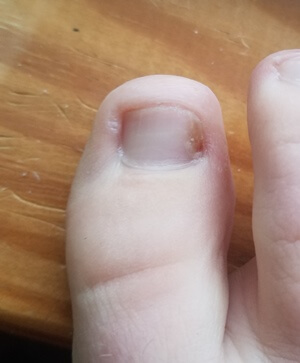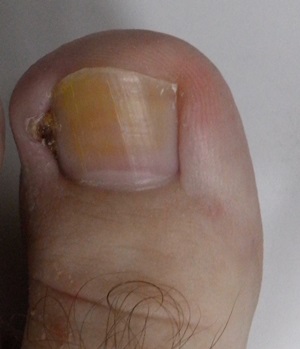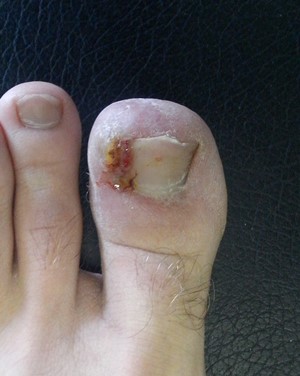What is an ingrown toenail? Put simply, it's pain in the toe around the sides of a toenail or fingernail caused by the nail itself.
Medical terminology: Onychocryptosis. From Greek ONYCHO - meaning "nail" and CRYPTO - meaning "hidden."

A common ingrown toenail
An ingrown toenail is a nail disease in which one or both sides of the nail irritate the surrounding skin. The irritation is caused by unusually high pressure from the side of the toenail. The pressure is most commonly due to the nail's high arch or outside pressure from shoes or socks that are too tight.
The free end of the toenail is not actually growing into the toe as the term "ingrown" might indicate. The side of the nail only appears to grow into the toe because it is being forced into the skin. See Ingrown Toenail Causes.
Pressure from the side of the toenail initially only causes minor discomfort. The toe may appear slightly red and inflamed. But, what starts as discomfort can quickly worsen if the pressure is enough to create a cut in the skin.
Ingrown toenails occur most frequently on the big toe but it can affect any toenail or even a fingernail. Usually just one side of the toenail will ingrow but occasionally both sides can become ingrown. Minor ingrown toenail cases may go away and not return once the source of the condition is corrected. Often ingrown toenails will appear and then go away repeatedly until they are treated appropriately. The condition tends to become worse the longer it goes untreated.
The severity of an ingrown toenail can be broken down into three stages:

Stage I - Mild Ingrown Toenail
Inflammation Stage. Symptoms and signs are redness, minor swelling, warmth and discomfort next to the nail. The toe is sensitive to pressure.
In this photo of a teenage female, the right corner of the toenail has been trimmed off in an effort to reduce its pressure on the skin. While this is practiced widely, it's not recommended because it encourages the nail to return with increasing curvature.
This individual has also trimmed her toenail too short, a common cause of ingrown toenails.

Stage II - Moderate Ingrown Toenail
Abscess Stage. The pain becomes more serious. Pus begins to form in the area. The toenail may penetrate the skin. Symptoms are bleeding, oozing of pus, increasing redness, warmth and swelling.
Initially, the pain may be bearable, but if the toenail cuts into the skin, the symptoms become more serious. Aside from pain, early signs and symptoms of ingrown toenails include tenderness, redness, or swelling in the toe, especially at the nail groove. The toe may feel hot. The skin beside the nail may also become hardened, with fluid building up around the area. When pressure is applied to the nail, the pain may worsen and be very painful. It can be painful to walk or wear shoes.
This individual has trimmed the left corner of his nail off to reduce its pressure on the toe. The sharp corner of the remaining nail has punctured the skin. This condition is very close to stage 3.

Stage III - Severe Ingrown Toenail
Granulation Stage. Tissue will grow over the inflamed area blocking pus drainage which eventually causes chronic inflammation.
Later stages may involve signs and symptoms such a bleeding and overgrowth of the skin surrounding the toenail. Infection can also occur, which can show as pus oozing from the punctured skin, yellowish-colored drainage, and increased redness and bleeding.
This is the toe of a younger male. He underwent ingrown toenail surgery (partial matrixectomy) two days after this photo was taken.
Diagnosis: What are the Signs of an Ingrown Toenail?
- Tenderness, warmth or a throbbing discomfort on either side of your big toe
- The skin is reddish and/or swollen on either side of your big toe
- Pain increases when you push on the toenail
- The toenail sometimes appears to be more curved than normal
- The side of your toenail is not visible. You have to pull the skin away to see the side of your toenail (and it may still not be visible when you do this)
- Bleeding, pus or drainage on the area of the toe where pain originates
- It hurts to walk or wear shoes
- While sleeping the weight of sheets and blankets on your toes may cause discomfort
Statistics: Who Gets Ingrown Toenails?
Ingrown toenails are extremely widespread. You probably know a number of individuals who are affected by ingrown toenails. Many don't talk about it or maybe they're embarrassed to say they have an ingrown toenail. Approximately 10% of the United States population, 32 million Americans, has experienced an ingrown toenail at some point in their life. Approximately 5% of the population reports having chronic ingrown toenails - a condition bad enough to require a doctor visit for periodic ingrown toenail treatment or ingrown toenail surgery.
An ingrown toenail can occur at any age. Most ingrown toenail cases are purely related to foot care so the condition does not discriminate, however women experience them more frequently because of more restrictive shoes such as high heels. It's common among athletes because of the need for tight fitting footwear and the pressures exerted on the toes. The appearance of a severe ingrown toenail prevents many individuals from exposing their feet in public with open-toed shoes or sandals, the opposite of what they really should be doing to prevent an ingrown toenail.
Other terms that describe an ingrown toenail and painful nail conditions:
-
Onychocryptosis
Onychocryptosis is the medical term for an ingrown toenail.
-
Unguis Incarnatus
Clinical terminology (Latin) for ingrown toenail. Translation: nail-in-flesh.
-
Involuted or Convoluted Toenail
An involuted or convoluted toenail is the same as an ingrown toenail. These terms are more commonly used in the UK.
-
Incurvated Toenail
An incurvated toenail is the same as an ingrown toenail. This term is more commonly used in Australia.
-
Pincer Toenail
A pincer toenail is a toenail that has developed extreme curvature. The ends of a pincer toenail appear to pinch the skin when viewed from the end.
-
Omega Toenail
An omega toenail is the same as a pincer nail. The toenail forms an omega (Ω) character when viewed from the end.
-
Trumpet Toenail
A trumpet toenail is similar to a pincer nail. The toenail appears to form a trumpet shape.
-
Ingrown Fingernail
An ingrown finger nail is the same as an ingrown toenail except it occurs on your finger. These are much less common than ingrown toenails.
